Planets Resin Models
1/72 Me 329 | 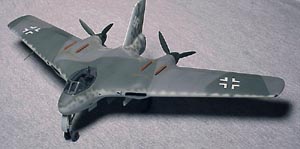 | History Following the failure of the Me 210 heavy fighter aircraft (which was upgraded to the Me 410 by lengthening the fuselage and adding more powerful engines), a search was begun on a new design for a twin-engine heavy fighter. Professor Alexander Lippisch began work on his Li P.10, and at the same time, Dr. Hermann Wurster independently developed the 329. After both submitted their ideas, Willy Messerschmitt asked to have a performance comparison drawn up between the Li P.10, Me 410 and Me 329. 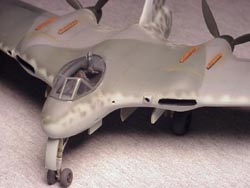 The Me 329 was a tailless design, and was to be constructed mainly of wood. This would save on strategic materials and keep the weight lower. As many components of the Me 410 were to be used as possible to save time on factory retooling. The Me 329 was a tailless design, and was to be constructed mainly of wood. This would save on strategic materials and keep the weight lower. As many components of the Me 410 were to be used as possible to save time on factory retooling. There were high hopes for the Me-329, and although a wooden mockup was built to check the placement of various components, production was not pursued due to the long development time for such a novel design. In addition, the Messerschmitt Me 410 was proving to be a success in many different roles with the upgrade additions from the Me 210. One source claims that the first prototype, the Me 329V1, was completed as a glider and test flown at the Rechlin Test Center in early 1945. This excerpt taken from www.luft46.com, a great web site. The Kit 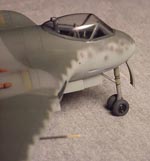 This is one the latest offerings from the Czech firm of Planet, one of the many divisions under the large MPM label. As with most Planet models, the lightweight end opening box is very similar to MPM and Condor kits, but a graphic display in line art graces the cover instead of full color renderings. The usual segmented poly bag contains all the well-done tan resin parts, each grouped in a segment, and each part was secure and undamaged. The last time this particular model was offered was the Airmodel resin kit, and before that was the well done Toad Resin multi-media kit. This kit is a re-casting of the Airmodel, which is not a bad thing seeing that the Airmodel kit was made by the parent company of Planet Resin. Planet Resin has also re-cast the Breda Ba-88, which was originally done by CMK resins. This is one the latest offerings from the Czech firm of Planet, one of the many divisions under the large MPM label. As with most Planet models, the lightweight end opening box is very similar to MPM and Condor kits, but a graphic display in line art graces the cover instead of full color renderings. The usual segmented poly bag contains all the well-done tan resin parts, each grouped in a segment, and each part was secure and undamaged. The last time this particular model was offered was the Airmodel resin kit, and before that was the well done Toad Resin multi-media kit. This kit is a re-casting of the Airmodel, which is not a bad thing seeing that the Airmodel kit was made by the parent company of Planet Resin. Planet Resin has also re-cast the Breda Ba-88, which was originally done by CMK resins.
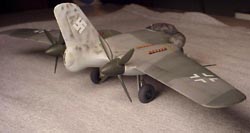 The main body is split horizontally, logically, as this is closer to a flying wing than a normal airframe; the single rudder is a separate part that needs to be removed from the molding block. Another part that has a hefty mold block is the cockpit floor that also doubles as the roof of the forward wheel well, so sand it down smooth and fairly thin. Despite the lack of a nose weight, I did not trust this was a nose sitter, so a few lead weights are glued forward of the center of gravity just in case. Be careful about how much weight you put in, I doubt the fragile landing gear will be able to hold much more than the weight of the resin kit for very long. The upper and lower fuselage fit well once the cockpit is in place, it is a bit random as far as placement of the front office, but trial fitting here is a good idea. The main body is split horizontally, logically, as this is closer to a flying wing than a normal airframe; the single rudder is a separate part that needs to be removed from the molding block. Another part that has a hefty mold block is the cockpit floor that also doubles as the roof of the forward wheel well, so sand it down smooth and fairly thin. Despite the lack of a nose weight, I did not trust this was a nose sitter, so a few lead weights are glued forward of the center of gravity just in case. Be careful about how much weight you put in, I doubt the fragile landing gear will be able to hold much more than the weight of the resin kit for very long. The upper and lower fuselage fit well once the cockpit is in place, it is a bit random as far as placement of the front office, but trial fitting here is a good idea. 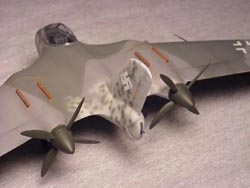 Next up are the two solid wings, making sure the injection gates are sanded smooth and flat to mate perfectly to the fuselage. Some sort of jig might be a good idea to make sure both wings have the same dihedral; mine were just placed and tacked using my trusty eyeballs. There are few seams to clean up, perhaps a touch of putty here and there depending on how the edges were cleaned up. A few pinholes in one of the leading edges need to be taken care of, but otherwise no other problems in the castings. The rudder is next, and care must be taken when removing it from its mold block. Follow the lines and clean up the edge, here again trial fitting is a good idea. Next up are the two solid wings, making sure the injection gates are sanded smooth and flat to mate perfectly to the fuselage. Some sort of jig might be a good idea to make sure both wings have the same dihedral; mine were just placed and tacked using my trusty eyeballs. There are few seams to clean up, perhaps a touch of putty here and there depending on how the edges were cleaned up. A few pinholes in one of the leading edges need to be taken care of, but otherwise no other problems in the castings. The rudder is next, and care must be taken when removing it from its mold block. Follow the lines and clean up the edge, here again trial fitting is a good idea. The whole airframe is starting to take shape, with only the small items left to clean up. The tedious task of removing the unwanted flash from the wafers consumed most of the assembly, but there are no concerns as the smaller parts actually look like they are supposed to. Conclusion Overall, this kit was pretty easy with well-engineered parts, even though it has to be at least 10-12 years old. The kit however does not conform to photos of the wooden mock-up done by Messerschmitt back in the early 1940s. The landing gear and rear remote turrets are only generalizations in the kit, with little data or drawings; 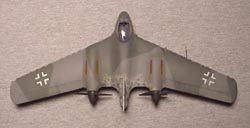 Airmodel/Planet Resins did the best they could. Airmodel/Planet Resins did the best they could. As you might have guessed, the last few items are applied once the final camouflage is laid done and detailed. This particular scheme is what one might find right around the time the Me-329 was designed, namely overall RLM 76 with a splinter of RLM 74/75 on the top surfaces. In the end, any scheme to your liking would be fine; as well as what types of markings you might like to see. That is the particular fascination of Luft’46 aircraft, you can make them like you want, and no one can tell you otherwise. This kit pegs out the Fun-O-Meter at a 10, ease of construction was an eight, and the Cool rating is again a 10. This all resin kit is not a tough one, so I can safely say most everyone with 10 toes or less could assemble this kit and have a wonderful end result. Thanks Planet Resin for bringing this one back! | 








|
